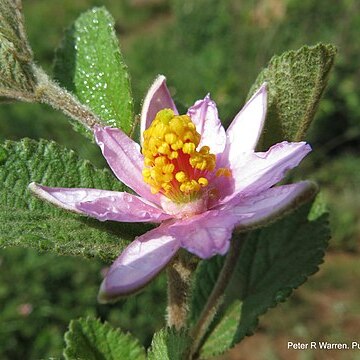Small tree or scandent shrub, up to 5 m high. Leaves broadly ovate to suborbicular up to 150 x 140 mm, strongly 3-nerved from base, apex rounded, base rounded, margins coarsely crenate-dentate. Inflorescences leaf-opposed, 2-4-flowered; peduncles up to 20 mm long, densely ferruginously hirsute. Flowers ± 17 mm long, pinkish lilac. Sepals narrowly oblong, up to 17 mm long, ferruginously tomentose outside, pink inside. Petals 3/4 the length of sepals. Androgynophore with basal portion glabrous ± 3 mm long, tomentose portion up to 1.5 mm long. Flowering time Nov.-Feb. Fruit brown to blackish, ± 25 mm in diam., 4-lobed, thin fleshy layer.
Scandent; twigs and petioles very hispid, with spreading, stellate hairs; leaves petiolate, roundish-ovate or cordate, obtuse, unequally dentato-crenate, 3-5-nerved at base, reticulate and harsh on the upper, softly pubescent on the lower side; peduncles solitary, axillary, longer than the petioles, forked, hispid, 2-4-flowered; fl.-buds globose, rufo-tomentose; sepals 3-nerved, longer than the petals; ovary hirsute; drupes hispid.
A straggling shrub. It grows to 3-5 m tall. The bark is smooth and grey. The leaves are large and almost round. They have hairs on the surface. The flowers are star shaped and pink. The fruit have 4 lobes and are red. They turn black when ripe.


